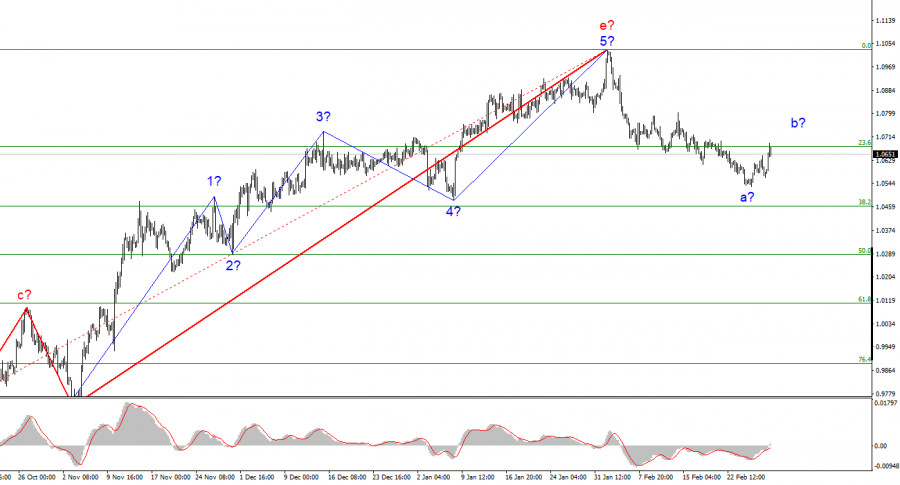

The 4-hour chart for the euro/dollar pair still shows the same wave pattern, which is excellent because it allows us to predict how the situation will develop. Although its amplitude would be more appropriate for the impulsive section, the upward part of the trend has been corrected. The wave pattern a-b-c-d-e that we were able to obtain features a wave e that is far more complex than the other waves. If the wave analysis is accurate, then this pattern's development is complete, and wave e was far longer than any other wave. I still anticipate a significant decrease in the pair because we are expected to develop at least three waves downward. A few days or weeks of inactivity are possible with the pair, though. The departure of quotes from the low hit on Monday signals the likely start of wave 2 or b. If this is the case, then any background news will result in a rise in quotes for a while. In any event, I anticipate a new, rather sharp decrease following the completion of this wave, as the pair must first create at least three waves downward before considering a potential new upward section.
For now, it is challenging to anticipate the positive effects of inflation in the European Union.On Wednesday, the euro/dollar pair increased by 90 basis points. So, there is every reason to believe that an additional downward trend segment, which will likely include an upward wave b, has started to form. I expected it to start shortly, but it turned out that the news background supported the euro currency and these two occurrences coincided. This is excellent news because there was no conflict between the waves and the news background. In Germany, the consumer price index for February was issued this morning. It showed the same annual growth rate of 8.7% as it did one month earlier. The annual growth rate of the harmonized indicator is now 9.3%. As a result, after only one month of decline, inflation in Germany has resumed its upward trend. This leads to a fairly straightforward conclusion: the ECB will keep raising interest rates. Although it has already reached 3%, it is obvious that inflation in the biggest economies of the European Union is essentially not going down. The consumer price index has slowed down in several nations, but it is impossible to predict that the European indicator will keep falling if it does not slow down sufficiently in Germany, France, or Spain.
The European regulator's previous efforts appear to have been in vain. The market has already accepted that the interest rate will increase by 50 basis points again in March, but at the current rates of inflation, such an increase is insufficient to predict a significant slowdown in price growth. This leads me to a clear conclusion: the ECB rate will continue to rise for a very long time. It may grow in one manner or another, but the rate of growth may slow down or there may be pauses. The market has already anticipated the next tightening of monetary policy at this point, therefore the support for the euro currency could not be very strong. The wave analysis continues to show that a decrease is necessary.

I draw the conclusion that the upward trend section's development is finished based on the analysis. As a result, it is now allowed to take into account sales with targets close to the predicted mark of 1.0284, or 50.0% Fibonacci. A correction wave 2 or b can be developed at this point, which should be considered. Opening sales now on the MACD "down" indications would be a good idea.
On the older wave scale, the ascending trend section's wave pattern has grown longer but is likely finished. The a-b-c-d-e pattern is most likely represented by the five upward waves we observed. The downward trend's development has already started, and it might have any size or structure.